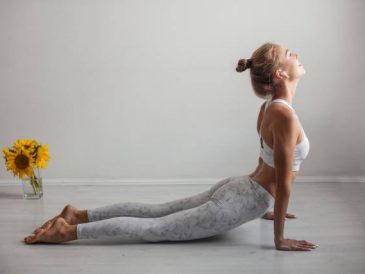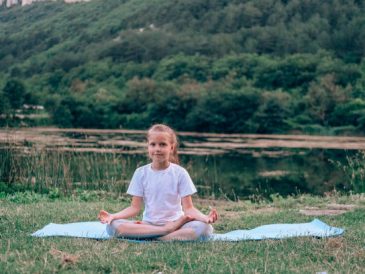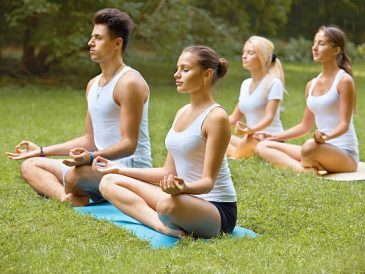Inversions are a staple of a good yoga practice. I like to think of inverting as the fountain of youth. Turning upside down or bringing the head below the heart can stimulate our nervous system, bring more oxygen and blood flow to the brain, boost our metabolic rate and energy levels, work the core, rouse the lymphatic system, and help with circulation.
Inversions are intimidating for beginners. However, they’re worth working on. They can also be incorporated into your daily practice. Inversions should be avoided if you have high blood pressure, are pregnant, or suffer from other health conditions. You can consult your doctor or stop doing them altogether if you do.
If you want to get more into your daily practice, the 30-Day Yoga Challenge is a great way to do so. You’ll start to see things in a new light when you begin going upside down each day.
Dogs that face downward
Downward Dog IS an inversion. My beginner students often think that inversions are only possible when you’re completely upside down. Downward Dog is a good way to get accustomed to the feeling of being upside down.
Downward Dog looks like a triangle, with the feet on one side and the hips on the other. Start on all fours. Tuck your toes in and bring your hips towards your heels. Engage your abs and begin to lift your hips in the air.
As you approach the pose, your feet may need to be pushed back further. As you return your weight to your legs, press firmly into your hands.
A common mistake is to lean the torso forward. Keep your knees bent if you have tight hamstrings. Lift the hips and continue to lift the legs. Allow your head to release and hold for 5-8 deep breaths.
As soon as you are comfortable with the Downward-Facing Dog, you can move on to the Three-Legged Dog or Dog Split by lifting your leg in the air and maintaining good form.
Dolphin Pose
Dolphin Pose helps beginners to build strength in their upper body and core.
I always suggest that beginners become comfortable with the dolphin pose before trying the headstand. This way, the foundation is already set. Before we go too far, let’s first learn how to do Dolphin Pose.
As you start on all fours, lower your elbows down to the mat. Make sure your wrists and elbows are aligned, and actively press your thumbs and forefingers. As you would in Downward Dog, lift your hips and spine. Hold 5-8 breaths.
Once you are comfortable with the position, try lifting your leg into a Dolphin Split. Alternate sides.
Headstand Prep
It is important to prepare for a headstand by finding the strength you need in your upper body. You can also work on raising your hips higher than your head.
As you would in Dolphin Pose (with your palms together), leave enough space between them to place a tennis ball.
Press down on the outer wrists and forearms to raise the shoulders away from your ears. Hold for 5 to 8 breaths while walking your feet as close as possible.
After you finish, rest in the Child’s Pose.
Wall T-Stand
This is my favorite inversion for beginners and all yogis. You are forced to use your legs and core as much when you are upside down.
Bring your mat up to a wall and get on all fours. Tuck your feet under the wall at the base. Keep your hands directly underneath your shoulders. Do not walk them forward. You can do this by lifting your butt into Down Dog and walking one leg up to the wall. Then, step up the other leg and straighten out the legs.
Hold for 3-5 breaths, eventually working your way up to 5-8 breaths.
You will be able to do a Handstand with ease if you master this pose.
Supported Shoulderstand
Shoulderstand, the queen asana of all the asanas, is often performed at the end of a class to calm the mind and slow down the pace. It is not a passive inversion.
It is important to maintain your core, legs, and arms in motion, particularly when the cervical spine may be at risk.
To prepare for the Shoulderstand, I suggest that all beginners place two blankets on top of each other at the back edge.
If you wish to increase your grip, you can fold the sticky mat over your forearms. Lay down on the support, with your shoulders and upper back on it. Your head should be off the back.
Then, interlace your hands and move the shoulders away from the cervical vertebrae by walking them towards the ears. Weight should be on the back of the head and arms.
When you are ready, lift your legs straight up to the sky. Engage your abs fully and lift your feet to the sky. If you can, hold 5-8 breaths. You may find that your body tends to fall into a banana-shaped position. To counteract this, lower the legs now and then.
Yoga is a lifetime journey. Inversions don’t require you to do any complicated arm balances.
Beginners can start with these inversions. You will soon have more energy and stamina. Your nervous system will be healthier, your body and immune system stronger, and you’ll feel better.




